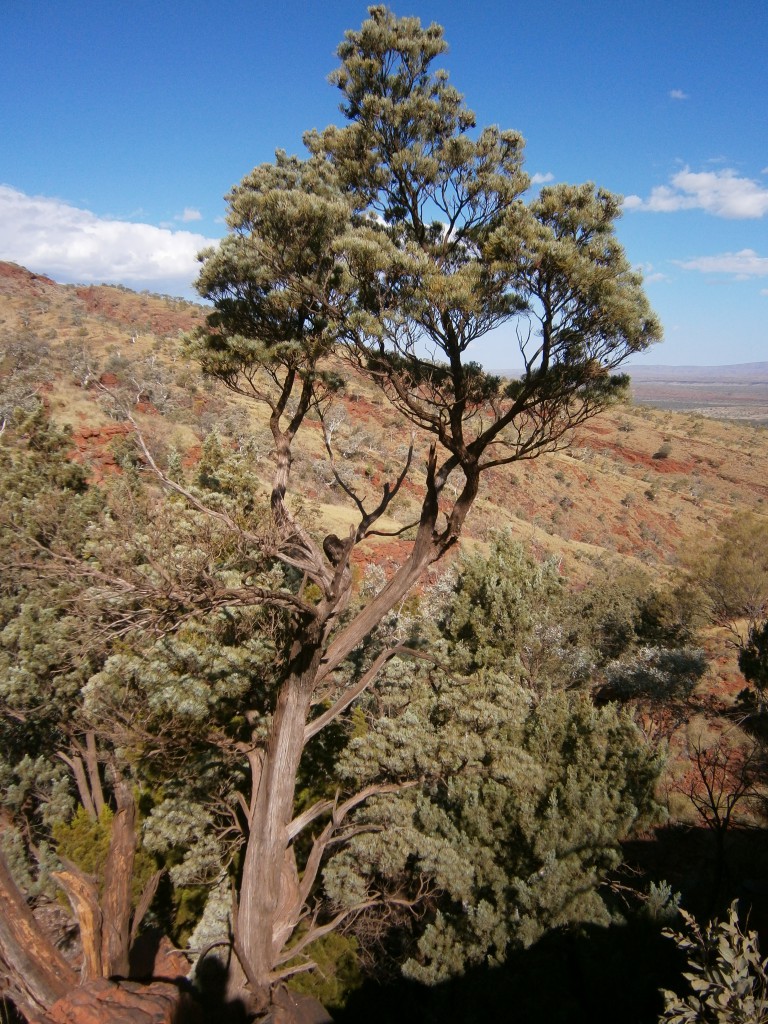
A cypress pine, or Callitris columellaris. This species is able to survive in Australia’s dry climates.
The activities are as follows:
- Teacher Guide
- Student activity, Level 3
- Grading Rubric
- An adapted version of the original scientific paper
- Excel spreadsheet of the full dataset for computer graphing exercises
Did you know that Australia is the driest inhabited continent in the world? Because it is so dry, we need to be able to predict how often and how much rain will fall. Predictions about future droughts help farmers care for their crops, cities plan their water use, and scientists better understand how ecosystems will change. The typical climate of arid northwest Australia consists of long drought periods with a few very wet years sprinkled in. Scientists predict that climate change will cause these cycles to become more extreme – droughts will become longer and periods of rain will become wetter. When variability is the norm, how can scientists tell if the climate is changing and droughts and rain events today are more intense than what we’ve seen in the past?
To make rainfall predictions for the future, scientists need data on past rainfall. However, humans have only recorded rainfall in Australia for the past 100 years. Because climate changes slowly and goes through long-term cycles, scientists need very long term datasets of rainfall.
The answer to this challenge comes from trees! Using dendrochronology, the study of tree rings, scientists get a window back in time. Many tree species add a ring to their trunks every year. The width of this ring varies from year to year depending on how much water is available. If it rains a lot in a year, the tree grows relatively fast and ends up with a wide tree ring. If there isn’t much rain in a year, the tree doesn’t grow much and the ring is narrow. We can compare the width of rings from recent years to the known rain data humans have collected. Then, assuming the same forces that determine tree ring width are operating today as in the past, we can go back and interpret how much rain fell in years where we have no recorded rainfall data. This indirect information from tree rings is known as a proxy, and helps us infer data about past climates.
For this study, the scientists used cypress-pine, or Callitris columellaris. This species is able to survive in Australia’s dry climates and is long lived enough to provide data far back in time. Fortunately, scientists don’t have to cut down the trees to see their rings. Instead, they use a corer – a hollow metal drill with the diameter of a straw. They drill it through the tree all the way to its core, and extract a sample of the tissue that shows all the tree rings. The scientists took 40 cores from 27 different cypress-pine trees. The oldest trees in the sample were more than 200 years old. Next, they developed a chronology where they lined up ring widths from one tree with all the other trees, wide with wide and narrow with narrow. This chronology gives them many replicate samples, and data going back all the way to the 19th century! Next, they used a dataset of rainfall from rain gauges that have been set out in Australia since 1910. They then take this precipitation data and overlay it with the tree ring widths since 1910. For tree rings before 1910, they then project back in time using a rainfall formula.
These videos, demonstrating the science of dendrochronology, could be a great way to spark class discussions:
Featured scientist: Alison O’Donnell from University of Western Australia
Flesch–Kincaid Reading Grade Level = 8.0
 This Data Nugget was adapted from a primary literature activity developed by Science Journal For Kids. For a more detailed version of this lesson plan, including a supplemental reading, videos, and extension activities, visit their website and register for free!
This Data Nugget was adapted from a primary literature activity developed by Science Journal For Kids. For a more detailed version of this lesson plan, including a supplemental reading, videos, and extension activities, visit their website and register for free!
There is one scientific paper associated with the data in this Data Nugget. The citation and PDF of the paper is below.
- O’Donnell, A.J., E.R. Cook, J.G. Palmer, C.S.M. Turney, G.F.M. Page, and P.F. Grierson (2015). Tree Rings Show Recent High Summer-Autumn Precipitation in Northwest Australia Is Unprecedented within the Last Two Centuries. PLoS ONE 10(6) e0128533.
- The same paper, written at a middle/high school reading level by Science Journal for Kids, can be found here.


